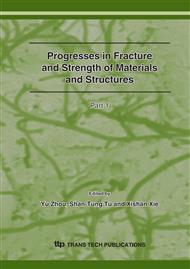p.2309
p.2313
p.2317
p.2321
p.2325
p.2329
p.2333
p.2337
p.2341
Damage Identification of Rock Mass with Artificial Neural Networks
Abstract:
The inverse problem of rock damage detection is formulated as an optimization problem, which is then solved by using artificial neural networks. Convergence measurements of displacements at a few of positions are used to determine the location and magnitude of the damaged rock in the excavation disturbed zones. Unlike the classical optimum methods, ANN is able to globally converge. However, the most frequently used Back-Propagation neural networks have a set of problems: dependence on initial parameters, long training time, lack of problemindependent way to choose appropriate network topology and incomprehensive nature of ANNs. To identify the location and magnitude of the damaged rock using an artificial neural network is feasible and a well trained artificial neural network by Levenberg-Marquardt algorithm reveals an extremely fast convergence and a high degree of accuracy.
Info:
Periodical:
Pages:
2325-2328
Citation:
Online since:
September 2007
Authors:
Price:
Сopyright:
© 2007 Trans Tech Publications Ltd. All Rights Reserved
Share:
Citation:


